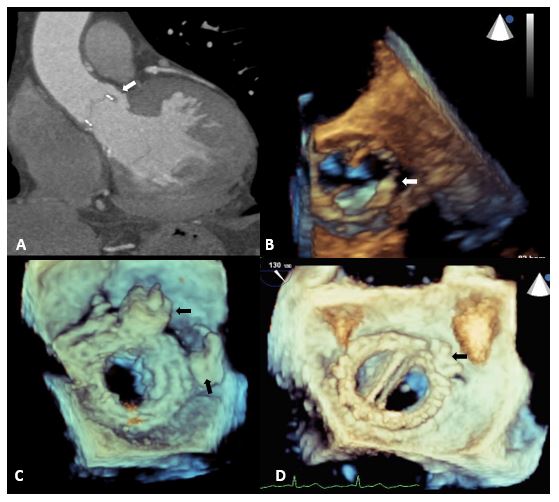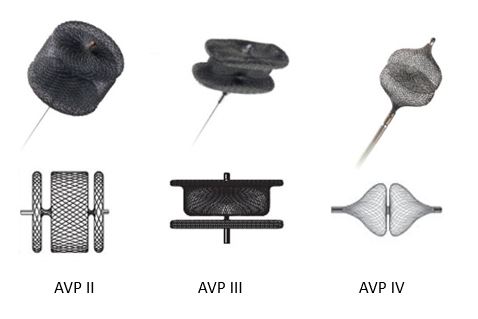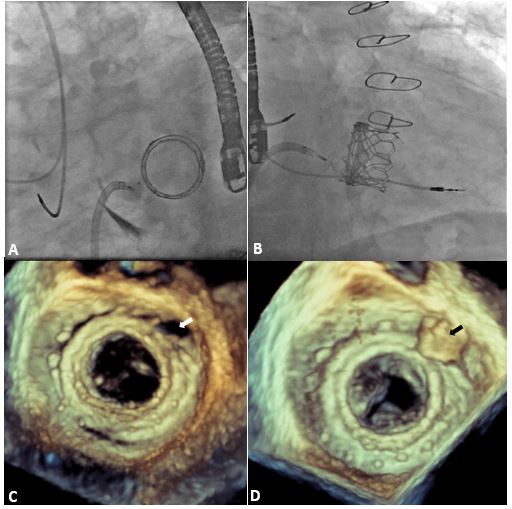Transcatheter Management of Paravalvular Leaks
Paravalvular prosthetic leak (PVL) or regurgitation is a serious and under-recognized condition affecting 6-15% of surgical prosthetic valves and annuloplasty rings.1,2 Moderate to severe PVL after surgical or transcatheter aortic valve replacement (TAVR) is associated with increased mortality.3 PVL can affect any valve in any position but is more common with mitral mechanical prostheses, supra-annular aortic prostheses,1 and use of sutures without pledgets or continuous sutures in the mitral position.4 PVL can present with congestive heart failure symptoms in patients with significant degree of regurgitation. Due to relative noncompliance of the receiving chamber, even a small volume of regurgitation can markedly increase left atrial pressure and induce clinical symptoms. Further elevation of pulmonary arterial pressures can lead to right-sided heart failure. PVL can also result in significant hemolytic anemia, more commonly encountered in patients with smaller defects and high-velocity jets, patients with pre-existing anemia, and patients with increased red blood cell fragility due to iron or folate deficiency.5
Paravalvular defects usually result from poor tissue quality related to friability from infection or calcification around the prosthetic valve. Because of the underlying anatomy, repeat surgery may not be successful in the presence of poor tissue integrity. Transcatheter PVL closure now offers a viable and less invasive alternative in such patients. The 2014 American College of Cardiology/American Heart Association guidelines for the management of valvular heart disease recommended percutaneous repair of PVL (Class IIa) for high-risk surgical patients with either intractable hemolysis or New York Heart Association (NYHA) Class III or IV heart failure who have anatomic features suitable for catheter-based therapy and when performed in centers with expertise in this procedure.6
Evaluation of PVL
Evaluation of PVL is challenging. Echocardiography is the primary imaging modality for patients with mitral PVL, and computed tomography (CT) can provide additive information (Figure 1). Although two-dimensional (2D) transthoracic echocardiography (TTE) or transesophageal echocardiography (TEE) can identify the presence of PVL, three-dimensional (3D) TEE is required for perimitral leaks for complete and accurate delineation of these defects. The chief aim of imaging is to define the defect (size, circumferential extent, location, and relation to the prosthetic valve leaflets) and the state of the ventricles. It is also vital to rule out any active endocarditis, excessive rocking motion of the valve, or significant valvular regurgitation, all of which preclude percutaneous repair. Cardiac CT allows further definition of the size and orientation of PVL in cases in which acoustic shadowing affects interpretation of echocardiographic images but is not needed routinely. Cardiac magnetic resonance (CMR) with accurate flow-imaging and volume-based measurements may be useful in certain cases in quantification of multiple paravalvular defects.7,8
Figure 1
For periaortic lesions, 2D TTE (and sometimes intra-cardiac echocardiography) allows for adequate visualization for anteriorly located lesions, and TEE is better for posterior aortic defects. Aortic PVL can be difficult to quantify at times, either due to strong color flow Doppler signals occupying the relatively small LV outflow tract (leading to overestimation) or acoustic shadowing (resulting in underestimation). The reverberation artefact and acoustic shadowing from the posterior valve ring can limit visualization of anterior PVLs even with 3D TEE. Aortography can be helpful to quantify regurgitation in such cases, although the inability to spatially characterize the leak and accurately identify orthogonal angles limits its value. We rarely use this. Electrocardiography-gated cardiac CT angiography can easily define location, size, shape, and trajectory of aortic paravalvular defects. This information allows for pre-procedural determination of optimal fluoroscopy plane or gantry angles to be used during the procedure.
No matter what imaging techniques are used, careful image review and discussion among interventional cardiologist, echocardiographer, and cardiac radiologist is a key pre-procedural step. Operators should understand precisely where the leak is before attempting to close and what technique is mostly likely to be successful.
Transcatheter Techniques for PVL Closure
There are no specific devices that have been designed or approved by the Food and Drug Administration (FDA) for PVL closure. PVLs vary in shape and tend to be crescentic with long serpiginous tracks rather than cylindrical, making it difficult for a single, round device to occlude leaks. The most commonly used occluder devices include the AMPLATZER Vascular Plug (AVP) family (St. Jude Medical; St. Paul, MN), comprising the AVP II and AVP IV (available in the United States) and AVP III (available in Europe) (Figure 2). Successful PVL closure requires careful pre-procedural planning and evaluation of diagnostic imaging as well as knowledge of prosthetic valves and their radiographic appearance. Skills in complex catheter techniques including transseptal and (sometimes) LV apical puncture, wire snaring and creation of rails, and vascular plug delivery are necessary.5
Figure 2: AVP Family
Mitral PVL Closure
Mitral PVL closure (Figure 3) is usually done under general anesthesia due to the need for intra-procedural TEE guidance. In the most commonly used "antegrade transseptal" approach, once the transseptal puncture is made, a 125-cm 5F multipurpose diagnostic catheter telescoped through a 6F 100-cm guide catheter (most commonly a multipurpose) is advanced into the left atrium (LA) through a steerable transseptal sheath. Use of a flexible LA sheath allows rapid access to even the most challenging medial locations adjacent to the interatrial septum. An exchange-length extra-support angled hydrophilic 0.035-inch wire passed through this telescoped catheter system is used to cross the defect guided by both biplane fluoroscopy and 3D TEE. Once the wire is in a stable position across the defect (usually advanced into the ascending aorta), the guide catheter is advanced into the LV. An AVP II of ≤12 mm will fit through a 6F coronary guide catheter without difficulty. If a larger device is required or if multiple devices need to be placed in a nested fashion, the telescoping system is exchanged for a Flexor Shuttle Sheath (Cook Medical; Bloomington, IN), advanced across the defect over an Amplatz Extra-Stiff wire (Cook Medical; Bloomington, IN) positioned in the LV. In the "anchor wire" technique for sequential delivery of multiple AVPs, after an AVP is deployed, the Flexor Shuttle Sheath is removed and then reloaded onto the guidewire and re-advanced across the defect, leaving the device on its delivery cable outside the sheath. This sequence can be repeated as many times as needed for successful closure of the defect. In case further support is needed, multiple devices can be deployed using a "stable A-V rail" technique. The hydrophilic wire in this technique is snared in the ascending aorta and exteriorized via femoral arterial access, forming an arteriovenous loop/rail. The catheters are then removed and replaced with a Flexor Shuttle Sheath, which is advanced through the defect while a second operator holds tension on both ends of the exteriorized wire to provide stability. Multiple devices can then be deployed in a fashion similar to the anchor wire technique. Major advantages of the anchor wire and rail techniques include the ability to deliver multiple devices without losing access and reversibility of the procedure. The rail technique provides the added advantage of stability and complete control of wire tension.
Figure 3: PVL Closure of a Mitral Valve-in-Valve
A "retrograde approach" involves crossing the defect from the LV into LA using a retroflexed diagnostic catheter through the aortic valve. The wire can then be snared in the LA and exteriorized via the transseptal approach forming an arteriovenous loop/rail. Occluder devices can then be deployed in an antegrade fashion via the stable rail technique described above. "Transapical LV puncture" is usually reserved for medial defects when catheter manipulation in the LA is limited or when interatrial septum is not suitable for transseptal approach (e.g., previous septal closure device). Defects are again crossed in the retrograde fashion as described.
Aortic PVL Closure
This is done most commonly in a retrograde fashion using a 125-cm 5F multipurpose diagnostic catheter telescoped through a 100-cm 6F multipurpose guide catheter. An Amplatz Left 1 coronary guide may be used for anterior defects, and a Judkins Right 4 catheter (Cordis; Miami Lakes, FL) might be better for some posterior defects. After crossing the defect with a hydrophilic glidewire, the guide catheter is advanced into the LV. Occluder devices can then be deployed, or the glidewire can be exchanged for an Amplatz Extra-Stiff wire (and the guide catheter exchanged for Flexor Shuttle Sheath) for extra stability. The anchor wire technique described above can also be used again for sequential delivery of multiple devices. If needed for extra stability, an arterio-arterial loop/rail can also be established by snaring the hydrophilic wire (advanced through the prosthetic valve) in the ascending/descending aorta and exteriorizing it to the contra-lateral femoral artery. Transapical access with or without creating a rail might also be used in some cases as described.
PVL Closure After TAVR
The incidence of PVL after TAVR has declined due to improved designs (e.g., sealing skirts), CT-guided optimal valve sizing, and operator experience. However, PVLs can still occur due to valve malposition, under expansion, or heavy annular/LV outflow tract calcification. The first two are treated by a valve-in-valve or balloon post-dilation, respectively, and PVL closure using a vascular plug is the treatment modality of choice for the last. Retrograde wire cannulation is occasionally challenging due to native valves-in-situ, bulky calcification, and the presence of sealing skirts in newer devices. The aortic frame struts present additional challenge in case of the CoreValve (Medtronic; Dublin, Ireland) for crossing the defect while avoiding the lattice. A high crossing position across the frame struts allows relatively easier deliverability of vascular plugs. AVP IV are commonly used for PVLs associated with TAVR due to smaller size and heavy calcification encountered in such defects. AVP IV range in size 4-8 mm and are easier to deliver through a 0.038-inch lumen catheter (including a 4F multipurpose catheter). This reduces the need to exchange for larger catheters/sheaths and avoids excessive manipulation.
Outcomes
Successful PVL closure is defined as reduction of regurgitation to grade ≤1, is achieved in ~70-90% of cases, and improves with increasing operator experience.9,10 Currently, 90% of even the most complex leaks can be closed successfully and without complications.10,11 Previous studies have demonstrated that a successful procedure with reduction of residual regurgitation to the lowest possible grades translated into superior clinical outcomes. This was seen in a previous meta-analysis (n = 362) in which successful PVL closure (compared with a failed intervention) was associated with significant improvement in NYHA class or hemolytic anemia (odds ratio, 9.95; 95% confidence interval, 2.1-66.7), reduction in need for cardiac surgery (odds ratio, 0.08; 95% confidence interval, 0.01-0.40), and, most importantly, lower cardiac mortality (odds ratio, 0.08; 95% confidence interval, 0.01-0.90).12
In a recently published analysis of 86 aortic PVL closures, Alkhouli et al. demonstrated successful reduction of residual regurgitation to mild or less in 62% of the cases with major adverse cardiac event rate of 5.1% at 30 days.13 In another previously published series of aortic and mitral PVL closures from Mayo Clinic, the 30-day complication rate was 8.7% (sudden and unexplained death was 1.7%; stroke was 2.6%; emergency surgery was 0.9%; and bleeding was 5.2%).11 Importantly, a significant improvement in procedural outcomes was noted with increasing operator experience in this study.11 This highlights the complexity and steep learning curve associated with this procedure, which requires commitment and a wide variety of procedural skills.
Important procedural complications can include prosthetic leaflet impingement (4%) and device embolization (<1%).5 Prosthetic leaflet impingement is more common in mechanical and stentless prosthesis, larger occluder devices with overhang. If it occurs, the occluder device needs to be readjusted or switched out for a smaller device. The anterior-superior defects are also prone to device movement once released. Device embolization can be prevented in most cases by ensuring stability of the device by pushing on it using the sheath/catheter while pulling on the delivery cable before releasing it. The device can be repositioned or changed for a larger device in case of instability. If the device embolizes, it usually will lodge in a common iliac artery, although smaller devices can embolize cranially. Embolized devices can be snared into the arterial sheath and removed. Aortography or selective coronary angiography might be necessary to rule out coronary obstruction that can occur with aortic PVL closure. Transapical access can be associated with postoperative bleeding (~20%) and hemothorax, requiring chest tube drainage especially when 6F sheath is used. Of note, apical puncture sites can be closed with vascular plugs when larger sheath sizes are used.
Future Directions
The outcomes of PVL closure have significantly improved over the years with growing experience and pre-procedural planning using advanced imaging modalities. There are little data on invasive hemodynamics that might provide procedural guidance as well as prognostic information about long-term outcomes following PVL closure. Most importantly, devices specifically designed for this purpose would likely improve outcomes and are in development. Advancements in intra-procedural imaging guidance like the use of fusion imaging with CT overlay during fluoroscopy will also be useful in facilitating the procedure.14
Conclusion
Successful PVL closure can be performed with low complication rates if done by experienced operators at centers of expertise. Careful pre-procedural planning, intra-procedural imaging, and experience in complex catheter skills are necessary to optimize procedural success. Every attempt should be made to achieve the lowest possible residual regurgitation to ensure superior clinical outcomes.
References
- Ionescu A, Fraser AG, Butchart EG. Prevalence and clinical significance of incidental paraprosthetic valvar regurgitation: a prospective study using transoesophageal echocardiography. Heart 2003;89:1316-21.
- O'Rourke DJ, Palac RT, Malenka DJ, Marrin CA, Arbuckle BE, Plehn JF. Outcome of mild periprosthetic regurgitation detected by intraoperative transesophageal echocardiography. J Am Coll Cardiol 2001;38:163-6.
- Sponga S, Perron J, Dagenais F, et al. Impact of residual regurgitation after aortic valve replacement. Eur J Cardiothorac Surg 2012;42:486-92.
- Englberger L, Schaff HV, Jamieson WR, et al. Importance of implant technique on risk of major paravalvular leak (PVL) after St. Jude mechanical heart valve replacement: a report from the Artificial Valve Endocarditis Reduction Trial (AVERT). Eur J Cardiothorac Surg 2005;28:838-43.
- Eleid MF, Cabalka AK, Malouf JF, Sanon S, Hagler DJ, Rihal CS. Techniques and Outcomes for the Treatment of Paravalvular Leak. Circ Cardiovasc Interv 2015;8:e001945.
- Nishimura RA, Otto CM, Bonow RO, et al. 2014 AHA/ACC Guideline for the Management of Patients With Valvular Heart Disease: executive summary: a report of the American College of Cardiology/American Heart Association Task Force on Practice Guidelines. Circulation 2014;129:2440-92.
- Lázaro C, Hinojar R, Zamorano JL. Cardiac imaging in prosthetic paravalvular leaks. Cardiovasc Diagn Ther 2014;4:307-13.
- Pflaumer A, Schwaiger M, Hess J, Lange R, Stern H. Quantification of periprosthetic valve leakage with multiple regurgitation jets by magnetic resonance imaging. Pediatr Cardiol 2005;26:593-4.
- Sorajja P, Cabalka AK, Hagler DJ, Rihal CS. The learning curve in percutaneous repair of paravalvular prosthetic regurgitation: an analysis of 200 cases. JACC Cardiovasc Interv 2014;7:521-9.
- Ruiz CE, Jelnin V, Kronzon I, et al. Clinical outcomes in patients undergoing percutaneous closure of periprosthetic paravalvular leaks. J Am Coll Cardiol 2011;58:2210-7.
- Sorajja P, Cabalka AK, Hagler DJ, Rihal CS. Percutaneous repair of paravalvular prosthetic regurgitation: acute and 30-day outcomes in 115 patients. Circ Cardiovasc Interv 2011;4:314-21.
- Millán X, Skaf S, Joseph L, et al. Transcatheter reduction of paravalvular leaks: a systematic review and meta-analysis. Can J Cardiol 2015;31:260-9.
- Alkhouli M, Sarraf M, Maor E, et al. Techniques and Outcomes of Percutaneous Aortic Paravalvular Leak Closure. JACC Cardiovasc Interv 2016;9:2416-26.
- Cruz-Gonzalez I, Rama-Merchan JC, Rodríguez-Collado J, et al. Transcatheter closure of paravalvular leaks: state of the art. Neth Heart J 2017;25:116-24.
Keywords: Anemia, Hemolytic, Aorta, Thoracic, Aortic Valve, Aortography, Arterial Pressure, Atrial Pressure, Angiography, Coronary Angiography, Echocardiography, Three-Dimensional, Echocardiography, Echocardiography, Transesophageal, Electrocardiography, Endocarditis, Femoral Artery, Fluoroscopy, Folic Acid, Heart Atria, Heart Failure, Heart Valve Diseases, Hemothorax, Iliac Artery, Magnetic Resonance Spectroscopy, Mitral Valve, Stroke, Transcatheter Aortic Valve Replacement
< Back to Listings



